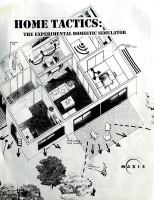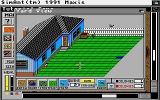 While Wright had many new game ideas after SimCity, he could never get them off the ground--especially his idea for a dollhouse game, which he had originally dubbed "Home Tactics: The Experimental Domestic Simulator."
While Wright had many new game ideas after SimCity, he could never get them off the ground--especially his idea for a dollhouse game, which he had originally dubbed "Home Tactics: The Experimental Domestic Simulator."
The idea for the dollhouse game partially stemmed from the Berkeley-Oakland fire of 1991, in which Wright's home was destroyed along with more than 3,800 others. As Wright and his family went about putting back together their life after the fire, he began to observe the way in which he reacquired items for their new home: First came the refrigerator, then the stove, and so on. In the dollhouse game, you'd do something similar: Design a dollhouse and then slowly acquire objects to put inside of it.
Wright explains that it began as a version of one of those 3D home building programs. "It kind of evolved from SimCity, when I was researching city planning and urban dynamics," says Wright. "At some point, I got more interested in architecture. The process that architects go through to design a house was really interesting to me. They start with a functional task description of where you spend your time and what kind of environments you need to support your activities. And that eventually evolves into a house plan. I was trying to figure out a way to turn that into a game about architecture. So I started down that path."
 One book in particular influenced his thinking about the game: A Pattern Language by Christopher Alexander, who laid out an architectural theory based on function rather than form. Alexander's rules were those common-sense ones most architects don't think twice about: Don't make a balcony more than six feet deep or it won't get used much; and if a roof appears to be supported only by spindly posts, it'll make people nervous.
One book in particular influenced his thinking about the game: A Pattern Language by Christopher Alexander, who laid out an architectural theory based on function rather than form. Alexander's rules were those common-sense ones most architects don't think twice about: Don't make a balcony more than six feet deep or it won't get used much; and if a roof appears to be supported only by spindly posts, it'll make people nervous.
While reading Alexander, Wright discovered a curious fact: Home-design software was selling millions of copies a year. Wright figured it was hardly likely that so many people were actually embarking on massive remodeling projects; in reality, they probably just wanted to play with architecture.
 Wright took the idea of architecture being a functional solution to life, coupled it with his fascination for 3D home architecture products and incorporated this into his game design. Wright wanted his game to allow people to design their perfect home.
Wright took the idea of architecture being a functional solution to life, coupled it with his fascination for 3D home architecture products and incorporated this into his game design. Wright wanted his game to allow people to design their perfect home.
The original prototype was really focused on the build mode. "The first thing I wanted was basically "Sim Architect" and I really enjoyed that. Even with the prototype I really enjoyed just building the different houses. That part I knew, very early on, worked for me. The home design part of the game I thought: 'I could spend hours on this."
Then, he needed to somehow "score" the architectural design, and that's where the Sims come in: Individuals who live in the house you design and provide you with feedback on how well it's put together. "At that point the people became the focus of the game because they were more interesting than the architecture." And that took the product off in a whole new direction. He shifted the game's focus to the time management. It went into how to simulate peoples' day-to-day activities. "I became interested in how much environmental design (architecture and so on) can influence and change behavior. I thought it would be really cool to bring that up to a level of consciousness."
 "The first time I really seriously thought that it felt like a buildable concept was as I was finishing SimAnt. In SimAnt was this strategic screen, where there was this entire backyard with a house that you were slowly trying to invade and occupy.
There was a little simulation of a guy who lived in the house who would sit and watch television, get food from the fridge, mow the lawn, stuff like that. I realized at the end of SimAnt that the simulation we built for the ants was almost more intelligent than for the guy, because the guy was being done using traditional programming. It got me wondering if there was a different way we could program people that will make them smarter. Then I started experimenting with some techniques, and that started the idea rolling."
"The first time I really seriously thought that it felt like a buildable concept was as I was finishing SimAnt. In SimAnt was this strategic screen, where there was this entire backyard with a house that you were slowly trying to invade and occupy.
There was a little simulation of a guy who lived in the house who would sit and watch television, get food from the fridge, mow the lawn, stuff like that. I realized at the end of SimAnt that the simulation we built for the ants was almost more intelligent than for the guy, because the guy was being done using traditional programming. It got me wondering if there was a different way we could program people that will make them smarter. Then I started experimenting with some techniques, and that started the idea rolling."
In the very first prototype in '93, a toilet was the one object in the game. You could build walls, you could move little guys around, you had terrain, and there was a toilet. That was the only object interaction. "It was an interesting object to me because it had so many different interactions with it. You know, you could clean the toilet, you could use the toilet..."
"Internally, 'The Sims' was a huge struggle getting it released, much more than 'SimCity,'" Wright says. "We had some focus groups with twelve year old boys and I was calling the game doll house at that point. And as soon as they heard that they ran out. So I stopped calling it that." Wright had the game running on a Macintosh, pitched the project to the Maxis executives and they rejected it; "they thought we couldn't do it. Those people wanted to keep doing SimCity, and they didn't think this concept made sense. So I was fighting just the internal structure of Maxis... which is the company I'd started!"
Almost overnight, Home Tactics was shifted to the back burner, with one lone programmer working on it in his spare time. "At this point I kind of took the whole thing underground. It became my black box project."

